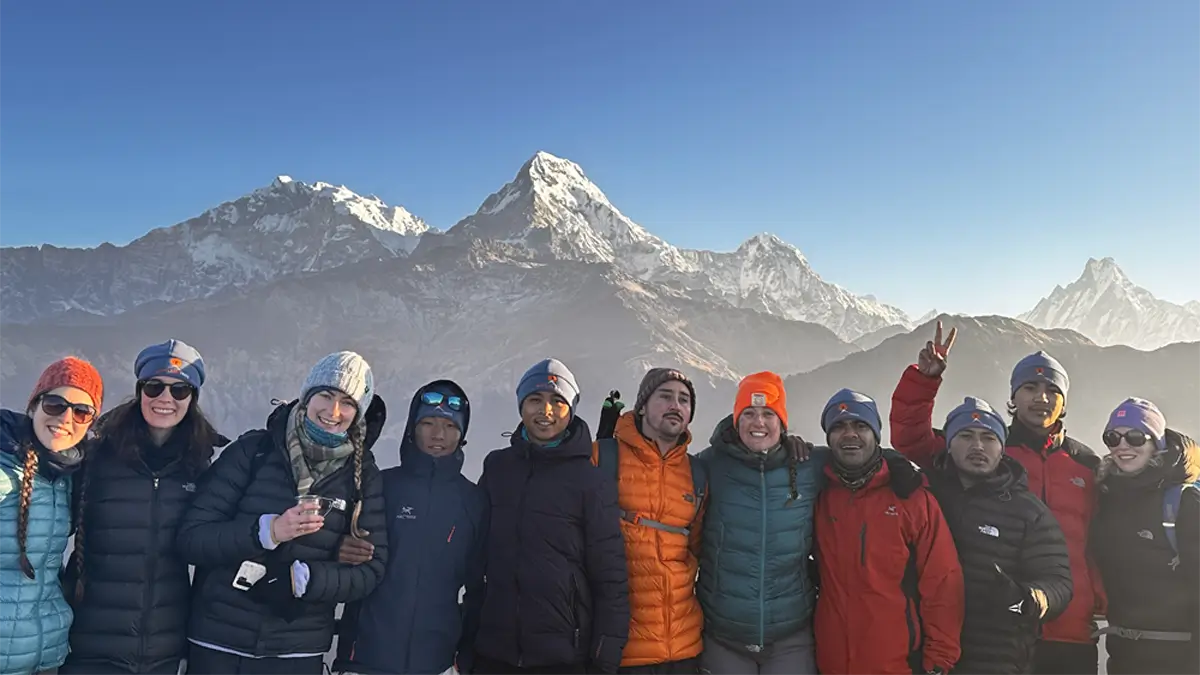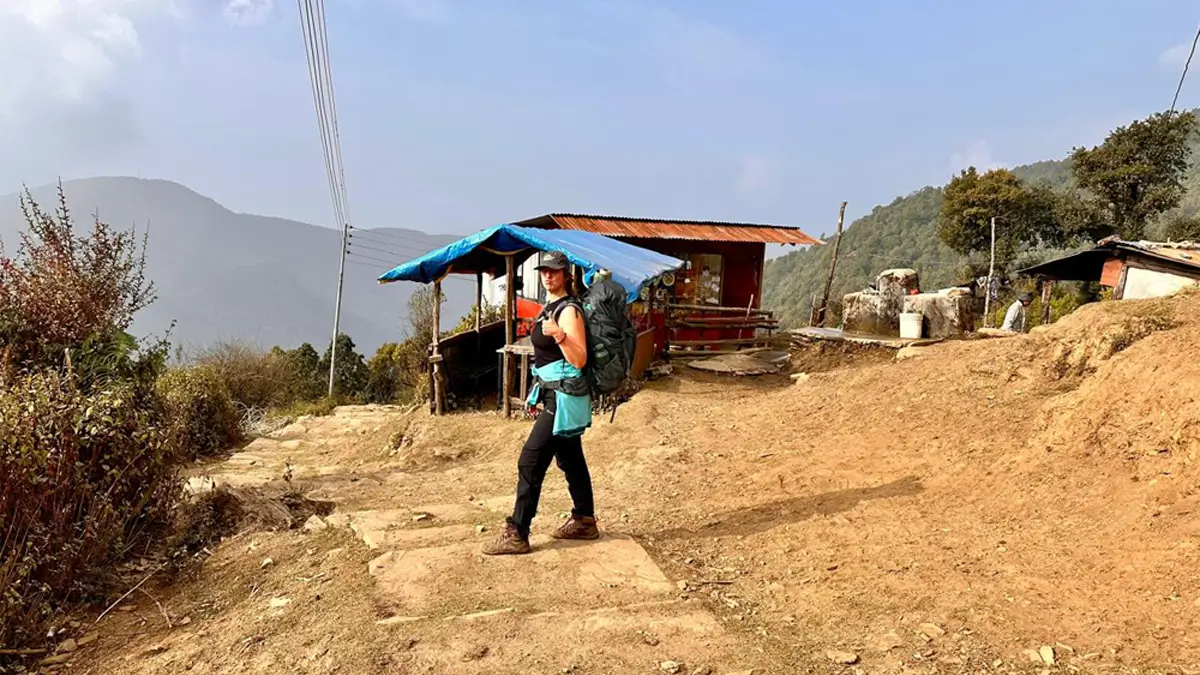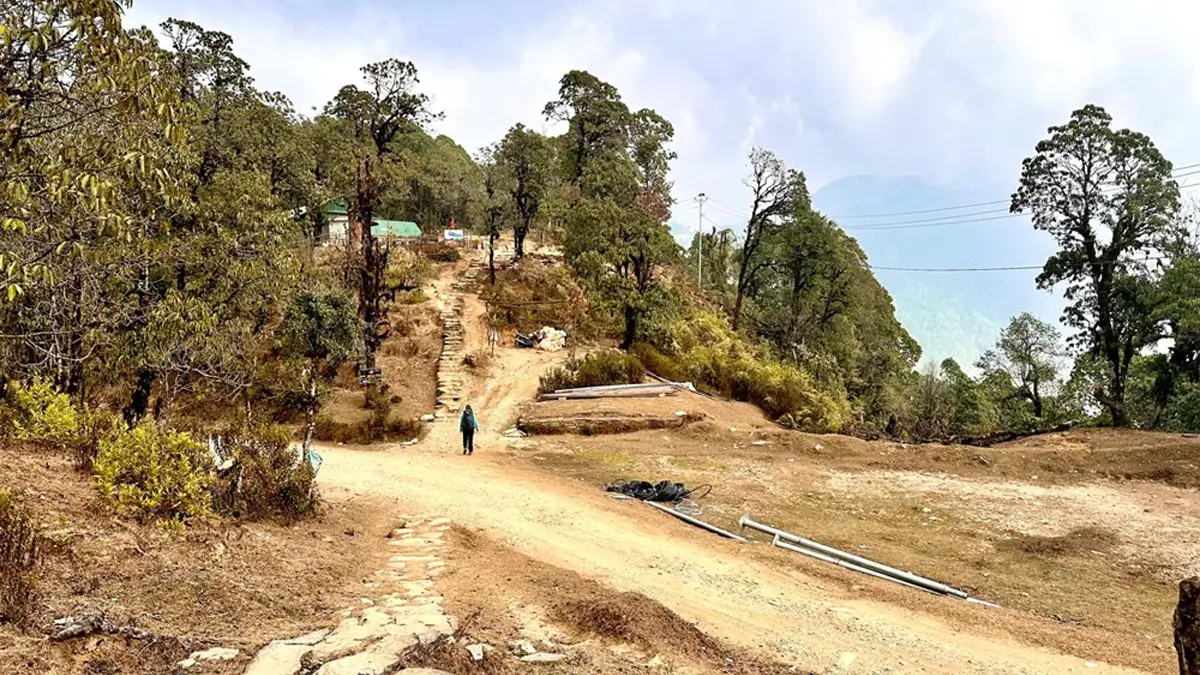Why Choose the Annapurna Himalayas View Short Trek in Nepal?

You could spend two weeks dragging your boots through snow, or you could get the same Himalayan drama in just a few days. The Annapurna Himalayas view short trek in Nepal is the platter of the Himalayas.
Here’s why this short but stunning trek wins every single time:
- Just big mountain views: You will be surrounded by giants like Annapurna South, Machhapuchhare (Fishtail), Hiunchuli, and Dhaulagiri, with the comfortable trails near Poon Hill, Ghorepani, or Ghandruk. Regardless of how busy you are, this 3 - 7- 8 day Annapurna panoramic view trek will make sure you see some beautiful vistas, forest walks, and mountain tea houses at any time, whether on weekends or just days off.
- There is cultural and comfort between the village and nature: You will walk through traditional Gurung or Magar villages where people greet you warmly and warm tea with a chilly smile. This is a cultural charm that is adventurous and comforting.
- This trek is also geared towards beginners: As the trails are well written, the altitude is manageable, and you don’t have to be an athlete to get the most out of the trail. If you can handle a few stairs, then you can handle the Short Annapurna View Trek.
This trek is for everyone, whether you are a first-timer, family traveller, or someone who mysteriously disappears on vacation one year or year after vacation.
When are the Best Seasons for the Annapurna View Short Trek?

If you have ever believed that “pick any time and wing it” is applicable to the Himalayas, then probably you would be hiking in fog and asking where those famous mountain views disappeared. And the weather can change at any time in the Himalaya Nepal.
So, the right season for the Annapurna Himalayas view short trek in Nepal should be chosen.
It is a viewpoint-based and short trek; thus, you will want clear, neat, and dry weather and trail, which is what spring and autumn give you.
There is no winner between them; they both possess their respective attractiveness, just like the combination of chocolate and coffee.
- Spring (March to May): Spring gives a wilderness of colours, rhododendron blossoms, soft rays of sun, and mesmerizing views. The temperatures during the day are nice, and the weather usually is. This is the best time for novice hikers, photographers, and nature lovers who wish to see the beautiful mingling of the flora and the Himalayas.
- Autumn (September to November): Autumn is the best in terms for trekking in Nepal. The monsoon has gone, and the crystal-clear skies are there, with crisp air and ridiculously close to the Himalayas.
The temperature stays pleasant, trails are not wet, and the nearby houses are teeming with people. It’s great for a family, a lone traveler, or a flock of photographers who want to capture the stunning Himalayan vista. Out of all months, October is definitely the brightest and best month.
To sum it up: Take Spring if you desire flowers, forests, and a soft, dreamy environment around the Himalayas.
Take autumn if you prefer sharp, high peaks, lively atmosphere, and super fabulous pictures. But you know the weather can change at any time in the mountains.
Is the Annapurna View Trek also Possible During the off-seasons?

Indeed, you can opt for the Annapurna Himalayas view short trek in Nepal during the non-peak seasons.
During the low season very quiet and very less people in the mountains. Just a little bit colder, but you can handle it very easily because this is not a high pass or advanced difficulty trek. Just make sure that you do have warm gear and clothes.
The two supposedly "off" periods are usually monsoon (June to August) and winter (December to February).
Now, here is the positive aspect: being a moderate-altitude trek, which usually peaks at around 3,300 meters, the off-season does not have such a harsh impact as it does on high-pass routes like Annapurna Thorong La, Manaslu Larke Pass or Everest Chola Pass.
However, there still are some trade-offs. Off-season really refers to a lower number of tourists, and also, trekking tea houses are open. But still, some people are doing the trek. And in the mountains, rainfall, snowfall can occur at any time.
Permits & Paperwork you Need for Annapurna View Trek
You can’t just stroll into the Annapurna Himalayas as Nepal takes its mountain business seriously.
The Annapurna Himalayas view short trek in Nepal might be 3 days to 9 days long, it depends on your time you want to spend there, but yes, you still need a couple of official permits before hitting the trail.
They help protect the fragile environment, fund local conservation and infrastructure, and make sure someone knows where you are.
Here’s your quick paperwork survival kit:
Annapurna Conservation Area Permit (ACAP): It’s your golden ticket to enter the Annapurna Conservation Area, and costs around NPR 3,000 (USD 25 to 30) per person.
TIMS Card (Trekkers’ Information Management System): It keeps a record of who is trekking and where, But TIMS CARD not required all the time. If required it will cost 25 USD 3000 Nepali rupees.
Getting these permits isn’t rocket science. You just need to bring a passport copy and a passport-size photo, then grab them from the Nepal Tourism Board (NTB) office in Kathmandu or Pokhara. Or, if you have booked your trip through a trekking agency, they will usually sort it all out.
Cost Overview of Annapurna View Panorama Trek
Nepal trekking is considered a rare travel deal of this kind, where one can enjoy the mountain views worth a million dollars and still not have to pay a million dollars.
The Annapurna Himalayas view short trek in Nepal is can be any days as you’re choice like minimum of 2 days to maximum eight, nine days in the mountain of the nature Himalaya trek experience that costs typically aroundUSD 2,97 – 1,119 USD, depending on which group you are trekking with, what is the season, according to the services, and how much comfort you like between climbs.
Then, what does that price cover? Most likely, it provides your transport, a licensed trekking guide who will lead you, comfortable tea house stays, all meals on the trail, and, of course, your permits. So far, all the logistical stuff that lets you focus on the important part.
By the way, what's not covered are international flights, Nepal entry visa, travel insurance, personal expenses, etc. If you are considering a deluxe stay or want a hot shower, you might need to spend a little bit more.
A few Extra Tips for Nepal Trekkers:
- Plan your hike wisely with timing: Wondering when to hike? Then, opt for the off-peak season, which is right after the rainy season, or just before the autumn rush. You will therefore avoid crowded places.
- Private Trek: If you do a private trek like with friends or family, that’s easier and more comfortable for you.
Like, no rush, no panic, just slow and chill with your own group, make tailor-made no need to catch other people, just on your peace, like slow and steady more comfortable.
- Make a friend: When you choose a group trek rather than a solo or private trek, the cost per person will be significantly reduced.
- Use your own bottle: Along the trek, refill your water bottle and take some electrolytes. It is a money-saving and hydration-maintaining way without the need to buy plastic bottles at every stop.
- Prepare for the hike by getting the necessary supplies: Carry your own snacks and other essentials because the same items will be priced at double the rate right at the high Himalaya trek including Annapurna short trekking trail.
How Difficult is the Short Trek in the Annapurna Himalayas?
For the short trekking to Annapurna view, you would be walking for about Five to seven hours a day, mainly at a leisurely pace with the added enjoyment of tea breaks, taking pictures, and encountering dogs now and then.
The path goes through mountain village, river side, stream, terraced hills, metal bridge, and forest paths that are all nice and easy to follow with good signs and care. The tramps will be a combination of stone steps, dirt roads, and moderate hills, but nothing that needs climbing skills.
Altitude is another huge factor in favor. The Annapurna view short trek does not take you to heights over 3,300 meters most of the time; thus, there’s very, very little chance of getting altitude sickness. Normally not altitude tho.
Every single day, there is an incline walking or hill walkingpath, but you have to climb stairs uphill and downhill also, haha
Moderate gain in elevation, so your body is allowed to get used to the hike without drama.
Nonetheless, a few surprises can come up depending on the season you choose to go. During the rainy season, trails might be quite slippery and muddy, and the winter season will have you waiting for the sun to thaw your will to hike in the mornings.
Safety Tips for the Short Trek to Annapurna Himalayas
- Always keep an eye on the weather because the mountains won’t send you warning texts.
- Drink a lot of water even if you do not feel thirsty since dehydration can come up silently when you are distracted by the stunning views.
- Going slow is a good idea in steep sections.
- Do not stray from the marked trails.
- Wear solid, comfy boots that will not let you slide on the stones that are wet.
- Put on layers since morning and evening can cool you off quicker than a Himalayan wind.
- Meals should not be skipped for any reason.
- Have along with you basic first aid that consists of band-aids, blister pads, and pain relievers.
- Obey your guideline; he/she is more familiar with the trail than Google Maps.
- Use sun protection, particularly on crisp days when the tops look like a spotlight.
- Do not pack too much.
- Even for a short trek, respect the limits of altitude; do not go further than the point where it becomes uncomfortable.
- Take a break, breathe, and enjoy the stunning views
Packing Essentials for Annapurna Himalayas View Short Trek in Nepal
Clothing:
- Lightweight trekking pants and breathable shirts
- Warm layers: fleece or down jacket
- Waterproof/windproof jacket
- Thermal base layers
- Hat, gloves, and scarf
- Comfortable sleepwear
Footwear:
- Trekking socks
- Sturdy trekking boots with good grip
- Camp shoes or sandals
Gear & Accessories:
- Daypack (20 to 30 L)
- Trekking poles
- Sunglasses
- Headlamp or flashlight
- Reusable water bottle or hydration system
- Camera or smartphone
- Power bank
- Rain covers for backpack
Personal Items:
- Personal toiletries (toothbrush, toothpaste, soap, quick-dry towel).
- Sunscreen & lip balm
- Small first aid kit (band-aids, blister pads, painkillers, antiseptic wipes).
- Prescription medications (if any).
- Hand sanitizer & wet wipes
- Passport copy, permits, and cash (NRs)
- Snacks (nuts, chocolate, energy bars)
for more information about Nepal trekking gear list.
Solo or Group Annapurna Himalayas View Trek
Honestly, the decision of whether to do an Annapurna view trek solo or in a group in Nepal is practically the same as calling for Netflix alone or a movie night with friends.
Highly recommend traveling with a local guide, especially in the Himalaya trek, for your safety, security, and easy access without any stress. And you are also helping locals to give them jobs as well.
Therefore, the main choices you have are:
- Group Trek (you + other trekkers + guide): Travelling with a group is another fun experience. with a new group of friends.
Sharing the experience and a trekking trail. You just have to follow the group rules and be with the group as well. Like everything on timing, like eating, walking, outgoing, etc. it is not really free like a private trip, but it is also free.
- Private Trek (you + guide, maybe a porter): This choice is for those who want to have full control over the speed of their trek. It is ideal for photographers and also for slow walkers. Nevertheless, you will have to spend more, but the advantages of flexibility and privacy will well compensate you.
Now, what would be the best option? The truth is, a private trek with a guide is the most balanced choice for the majority of tourists.
You can travel at your own peace, enjoy the scenery, and not waste time getting aligned with the group’s schedules. You will enjoy the Annapurna Himalayas is full of great fun and memories.
Why This Short Annapurna Panorama Trek Should Be on Your Nepal List?
In case you believe that the only way to see the tremendous views of the Himalayas is through a long trek of weeks, allow the Annapurna Himalayas view trek to change your mind. This short and sweet path is powerful, giving energy, and surprisingly contenting despite its size.
The trip is the ideal combination of luxury, local life, and Himalayan magnificence, without the drawbacks of high altitude or a long stay. If you are short on time, a beginner in trekking, or only want a quick mountain fix, this trek would fit perfectly into your Nepal adventure.
FAQ
How many days Annapurna Himalayas view trek in Nepal?
Annapurna Himalaya view short trek, it depends on the duration that you’re choosing, like a minimum trekking in the mountains 2 days, but normally 3-5 days would be great and enough time to explore and enjoy the mountain view.
Can I see the Himalaya view from the Annapurna trek?
Yes, you can see the Annapurna Himalaya view range, including Dhaulagiri, Fishtail, and many more.
Where can I start to Annapurna view trek?
You can start your Annapurna view trekking either from Kathmandu or Pokhara. But according to the trekking routes, you start walking from different places.
How many hours shall we have to walk on the Annapurna view trek?
Depends on the routes you choose but normally 5-7 hours walk per day including your break and photography time.
Is Annapurna view trek being hard?
Normally not, Annapurna view trek easily and moderate walk. There is uphill and downhill as well.
How do I arrange my Annapurna view trek?
You can arrange and book the trek by local operator trekking agency and tour company.
Do I need a trekking permit for the Annapurna view trekking in Nepal?
Yes, you need a trekking entry permit for the Annapurna view trekking, and also permit for all trekking routes in Nepal.







